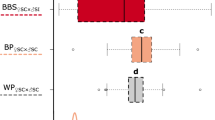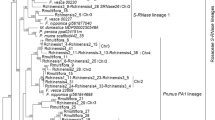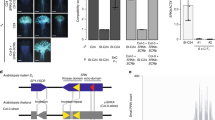Abstract
Many flowering plants have adopted self-incompatibility mechanisms to prevent inbreeding and promote out-crosses1. In the Solanaceae, Rosaceae and Scrophulariaceae, two separate genes at the highly polymorphic S-locus control self-incompatibility interactions: the S-RNase gene encodes the pistil determinant and the previously unidentified S-gene encodes the pollen determinant2,3,4. S-RNases interact with pollen S-allele products to inhibit the growth of self-pollen tubes in the style. Pollen-expressed F-box genes showing allelic sequence polymorphism have recently been identified near to the S-RNase gene in members of the Rosaceae and Scrophulariaceae5,6,7,8; but until now have not been directly shown to encode the pollen determinant. Here we report the identification and characterization of PiSLF, an S-locus F-box gene of Petunia inflata (Solanaceae). We show that transformation of S1S1, S1S2 and S2S3 plants with the S2-allele of PiSLF causes breakdown of their pollen function in self-incompatibility. This breakdown of pollen function is consistent with ‘competitive interaction’, in which pollen carrying two different pollen S-alleles fails to function in self-incompatibility1,9,10. We conclude that PiSLF encodes the pollen self-incompatibility determinant.
This is a preview of subscription content, access via your institution
Access options
Subscribe to this journal
Receive 51 print issues and online access
$199.00 per year
only $3.90 per issue
Buy this article
- Purchase on Springer Link
- Instant access to full article PDF
Prices may be subject to local taxes which are calculated during checkout




Similar content being viewed by others
References
de Nettancourt, D. Incompatibility and Incongruity in Wild and Cultivated Plants (Springer, Berlin, 2001)
Lee, H.-S., Huang, S. & Kao, T.-h. S proteins control rejection of incompatible pollen in Petunia inflata. Nature 367, 560–563 (1994)
Murfett, J., Atherton, T. L., Mou, B., Gasser, C. S. & McClure, B. A. S-RNase expressed in transgenic Nicotiana causes S-allele-specific pollen rejection. Nature 367, 563–566 (1994)
Kao, T.-h. & Tsukamoto, T. The molecular and genetic bases of S-RNase-based self-incompatibility. Plant Cell advance online publication 9 March 2004 (doi:10.1105/tpc.016154)
Lai, Z. et al. An F-box gene linked to the self-incompatibility (S) locus of Antirrhinum is expressed specifically in pollen and tapetum. Plant Mol. Biol. 50, 29–42 (2002)
Entani, T. et al. Comparative analysis of the self-incompatibility (S-) locus region of Prunus mume: identification of a pollen-expressed F-box gene with allelic diversity. Genes Cells 8, 203–213 (2003)
Ushijima, K. et al. Structural and transcriptional analysis of the self-incompatibility locus of almond: identification of a pollen-expressed F-box gene with haplotype-specific polymorphism. Plant Cell 15, 771–781 (2003)
Zhou, J. et al. Structural and transcriptional analysis of S-locus F-box (SLF) genes in Antirrhinum. Sex. Plant Reprod. 16, 165–177 (2003)
Golz, J. F., Su, V., Clarke, A. E. & Newbigin, E. A molecular description of mutations affecting the pollen component of the Nicotiana alata S locus. Genetics 152, 1123–1135 (1999)
Golz, J. F., Oh, H.-Y., Su, V., Kusaba, M. & Newbigin, E. Genetic analysis of Nicotiana pollen-part mutants is consistent with the presence of an S-ribonuclease inhibitor at the S locus. Proc. Natl Acad. Sci. USA 98, 15372–15376 (2001)
McCubbin, A. G., Zuniga, C. & Kao, T.-h. Construction of a binary artificial chromosome library of Petunia inflata and the identification of large genomic fragments linked to the self-incompatibility (S-) locus. Genome 43, 820–826 (2000)
Wang, Y. et al. Chromosome walking in the Petunia inflata self-incompatibility (S-) locus and gene identification in an 881-kb contig containing S 2-RNase. Plant Mol. Biol (in the press)
Ai, Y. et al. Self-incompatibility in Petunia inflata: isolation and characterization of cDNAs encoding three S-allele-associated proteins. Sex. Plant Reprod. 3, 130–138 (1990)
Wang, Y., Wang, X., McCubbin, A. G. & Kao, T.-h. Genetic mapping and molecular characterization of the self-incompatibility (S-) locus in Petunia inflata. Plant Mol. Biol. 53, 565–580 (2003)
Luu, D.-T. et al. Rejection of S-heteroallelic pollen by a dual-specific S-RNase in Solanum chacoense predicts a multimeric self-incompatibility pollen component. Genetics 159, 329–335 (2001)
Huang, S., Lee, H.-S., Karunanandaa, B. & Kao, T.-h. Ribonuclease activity of Petunia inflata S proteins is essential for rejection of self-pollen. Plant Cell 6, 1021–1028 (1994)
Luu, D.-T., Qin, K., Morse, D. & Cappadocia, M. S-RNase uptake by compatible pollen tubes in gametophytic self-incompatibility. Nature 407, 649–651 (2000)
Qiao, H. et al. The F-box protein AhSLF-S2 physically interacts with S-RNases that may be inhibited by the ubiquitin/26S proteasome pathway of protein degradation during compatible pollination in Antirrhinum. Plant Cell 16, 582–595 (2004)
Bai, C. et al. Skp1 connects cell cycle regulation to the ubiquitin proteolysis machinery through a novel motif, the F-box. Cell 86, 263–274 (1996)
Skirpan, A. L. et al. Isolation and characterization of kinase interacting protein 1, a pollen protein that interacts with the kinase domain of PRK1, a receptor-like kinase of petunia. Plant Physiol. 126, 1480–1492 (2001)
Mu, J.-H., Lee, H.-S. & Kao, T.-h Characterization of a pollen-expressed receptor-like kinase gene of Petunia inflata and the activity of its encoded kinase. Plant Cell 6, 709–721 (1994)
Acknowledgements
We thank A. H. Omeis for the greenhouse work, J. Wang for routine laboratory assistance and the Monsanto Sequencing Facility for sequencing the BAC clones. This work was supported by a Predoctoral Fellowship for Students with Disabilities from the National Institutes of Health (P.E.D.) and by grants from the National Science Foundation (T.-h.K.).
Author information
Authors and Affiliations
Corresponding author
Ethics declarations
Competing interests
The authors declare that they have no competing financial interests.
Supplementary information
Supplementary Figure S1
Alignment of the deduced amino acid sequences of three alleles of an S-locus F-box gene of Petunia inflata, named PiSLF. (JPG 184 kb)
Supplementary Figure S2
Schematic of the PiSLF2 construct used in all transformation experiments to generate transgenic plants expressing the PiSLF2 transgene. (JPG 20 kb)
Rights and permissions
About this article
Cite this article
Sijacic, P., Wang, X., Skirpan, A. et al. Identification of the pollen determinant of S-RNase-mediated self-incompatibility. Nature 429, 302–305 (2004). https://doi.org/10.1038/nature02523
Received:
Accepted:
Issue Date:
DOI: https://doi.org/10.1038/nature02523
This article is cited by
-
Ac-DEVD-CHO (caspase-3/DEVDase inhibitor) suppresses self-incompatibility–induced programmed cell death in the pollen tubes of petunia (Petunia hybrida E. Vilm.)
Cell Death Discovery (2024)
-
Specific functions of single pistil S-RNases in S-gene homozygous Pyrus germplasm
BMC Plant Biology (2023)
-
Physiological changes besides the enhancement of pigmentation in Petunia hybrida caused by overexpression of PhAN2, an R2R3-MYB transcription factor
Plant Cell Reports (2023)
-
Recent advances and challenges in potato improvement using CRISPR/Cas genome editing
Planta (2023)
-
Genetics Behind Sexual Incompatibility in Plants: How Much We Know and What More to Uncover?
Journal of Plant Growth Regulation (2023)
Comments
By submitting a comment you agree to abide by our Terms and Community Guidelines. If you find something abusive or that does not comply with our terms or guidelines please flag it as inappropriate.



